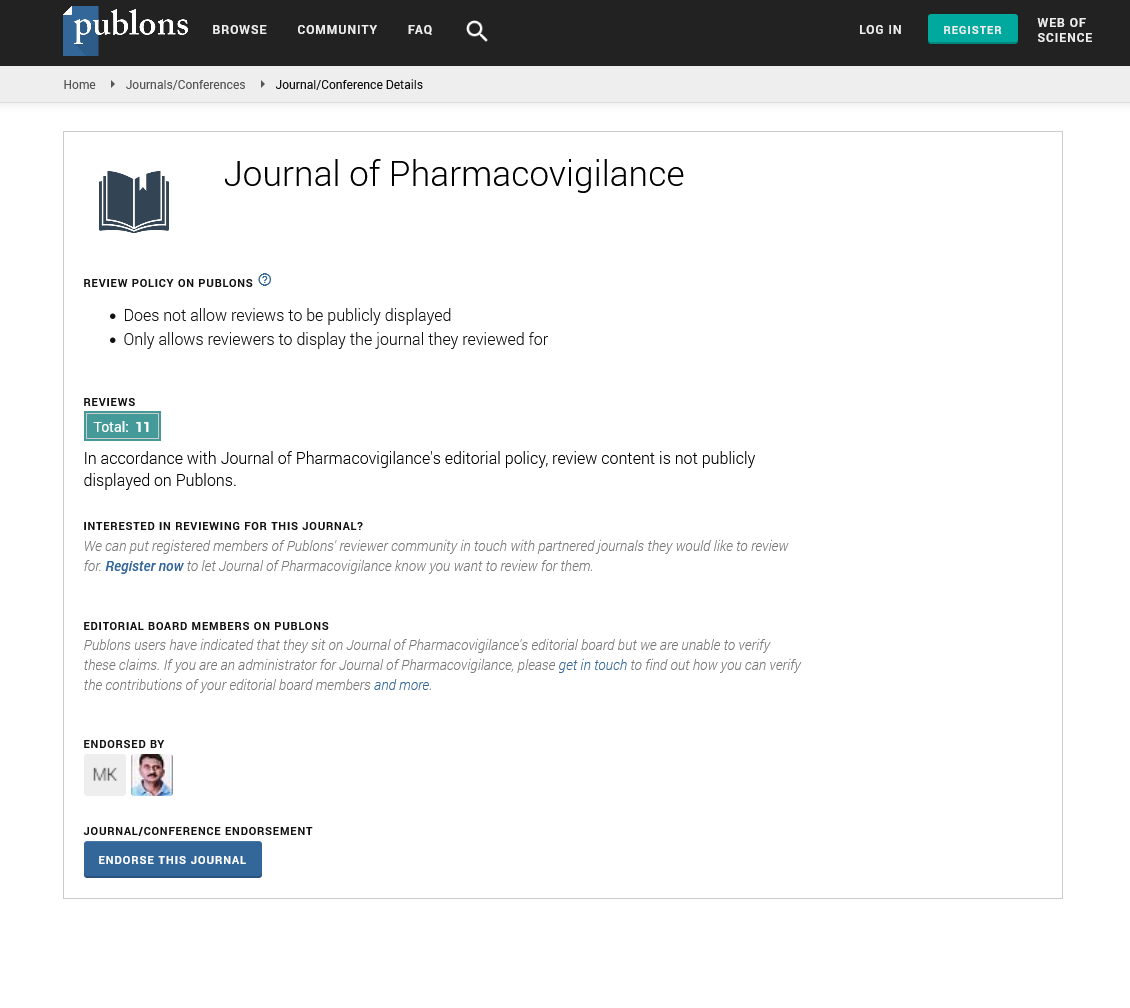Indexed In
- Open J Gate
- JournalTOCs
- The Global Impact Factor (GIF)
- RefSeek
- Hamdard University
- EBSCO A-Z
- OCLC- WorldCat
- Publons
- Euro Pub
- Google Scholar
Useful Links
Share This Page
Journal Flyer

Open Access Journals
- Agri and Aquaculture
- Biochemistry
- Bioinformatics & Systems Biology
- Business & Management
- Chemistry
- Clinical Sciences
- Engineering
- Food & Nutrition
- General Science
- Genetics & Molecular Biology
- Immunology & Microbiology
- Medical Sciences
- Neuroscience & Psychology
- Nursing & Health Care
- Pharmaceutical Sciences
Risk of gastrointestinal complications associated to NSAIDs, low-dose aspirin and their combinations: Results of a pharmacovigilance reporting system
11th International Conference and Exhibition on Pharmacovigilance & Drug Safety
June 21-22, 2018 | London, UK
Cristina Scavone
University of Campania Luigi Vanvitelli, Italy
Scientific Tracks Abstracts: J Pharmacovigil
Abstract:
Gastrointestinal (GI) complications are one of the most limiting cause of use of NSAIDs. Beyond others well defined factors, history of peptic ulcer, older age, Helicobacter pylori infection and use of gastrotoxic drugs may affect their GI safety profile. In particular, the risk of GI complications associated to the use of antiplatelet drugs, especially low-dose acetylsalicylic acid (LDA) should deserve much attention. However, only few studies have focused on the effect of combination LDA/NSAIDs on the GI tract compared with the monotherapy and much less studies assessed this effect with multiple NSAIDs use. We aimed to characterize the GI safety profile of NSAIDs and LDA as monotherapy or their combinations in real-life conditions by analyzing spontaneous adverse drug reactions (ADRs) reporting system in a Southern Italy. We used the case/non-case method in the Italian Pharmacovigilance Network (RNF). Cases were reports of GI events in the RNF between January 2007 and December 2011. Non-cases were all other reports during the same period. The association between NSAID and suspected GI ADRs was calculated using the reporting odds ratio (ROR) with 95% confidence intervals as a measure of disproportionality while adjusting for age, and concomitant use of antineoplastic agents or drugs for cardiovascular diseases. Sub-analyses were performed within the NSAID class. Among the 2816 adverse drug reactions recorded, we identified 374 (13.3%) cases of GI complications. Upper GI complications were the most frequently reported type of events. The highest associations were found for the combined use of NSAIDs and/or LDA, whilst the lowest associations were for their respective monotherapy. Looking at individual NSAIDs the highest association with GI events was observed for ketorolac exposure followed by nimesulide, diclofenac, aspirin, Ketoprofen, and ibuprofen. This study highlights the primary role of the national spontaneous reporting system to bring out potential signals, such as the inappropriate drug use pattern, which however, have to be furtherly studied in-depth with ad hoc population-based studies. Recent Publications 1. Sessa M, Rossi C, Mascolo A, Scavone C, di Mauro G, Grassi R, Sportiello L, Cappabianca S, Rafaniello C. Contrast media-induced nephropathy: how has Italy contributed in the past 30 years? A systematic review. Ther Clin Risk Manag. (2017);13:1463-1478. 2. Scavone C, Rafaniello C, Berrino L, Rossi F and Capuano A (2017) Strengths, weaknesses and future challenges of biosimilars development. An opinion on how to improve the knowledge and use of biosimilars in clinical practice. Pharmacol Res. 126: 138-142. 3. Auricchio F, Scavone C, Cimmaruta D, Di Mauro G, Capuano A, Sportiello L, Rafaniello C. (2017 ) Drugs approved for the treatment of multiple sclerosis: review of their safety profile. Expert Opin Drug Saf. 16(12):1359-1371. 4. Scavone C, Sportiello L, Sullo M G, Ferrajolo C, Ruggiero R, Sessa M, Berrino P M, di Mauro G, Berrino L, Rossi F, Rafaniello C and Capuano A (2017) Safety Profile of Anticancer and Immune-Modulating Biotech Drugs Used in a Real World Setting in Campania Region (Italy): BIO-Cam Observational Study. Front Pharmacol. Sep 6(8) 607. 5. Ferrajolo C, Scavone C, Donati M, Bortolami O, Stoppa G, Motola D, Vannacci A, Mugelli A, Leone R, Capuano A (2018); DILI-IT Study Group. Antidepressant-Induced Acute Liver Injury: A Case-Control Study in an Italian Inpatient Population. Drug Saf. 41(1):95-102. 6. Mascolo A, Scavone C, Sessa M, di Mauro G, Cimmaruta D, Orlando V, Rossi F, Sportiello L and Capuano A (2017) Can causality assessment fulfill the new European definition of adverse drug reaction? A review of methods used in spontaneous reporting. Pharmacol Res. Sep;123:122-129. 7. Sessa M, Sportiello L, Mascolo A, Scavone C, Gallipoli S, di Mauro G, Cimmaruta D, Rafaniello C and Capuano A (2017) Campania Preventability Assessment Committee (Italy): A Focus on the Preventability of Non-steroidal Antiinflammatory Drugs' Adverse Drug Reactions. Front Pharmacol. 26; 8:305. 8. Cappetta D, Esposito G, Coppini R, Piegari E, Russo R, Ciuffreda LP, Rivellino A, Santini L, Rafaniello C, Scavone C, Rossi F, Berrino L, Urbanek K and De Angelis A (2017) Effects of ranolazine in a model of doxorubicin-induced left ventricle diastolic dysfunction. Br J Pharmacol. 174(21):3696-3712. 9. Scavone C, Sportiello L, Berrino L, Rossi F and Capuano A (2017) Biosimilars in the European Union from comparability exercise to real world experience: What we achieved and what we still need to achieve. Pharmacol Res. 119:265-271. 10. Sportiello L, Rafaniello C, Sullo M G, Nica M, Scavone C, Bernardi F F, Colombo D M and Rossi F (2016) No substantial gender differences in suspected adverse reactions to ACE inhibitors and ARBs: results from spontaneous reporting system in Campania Region. Expert Opin Drug Saf. 15(sup2):101- 07.
Biography :
Cristina Scavone is a pharmacist attending the last year of PhD in translational medicine. She plays her scientific research as a PhD student at the Department of Experimental Medicine of University of Campania “Luigi Vanvitelli” and at the Pharmacovigilance and Pharmacoepidemiology Center. Her research activities are directed to the topic of pharmacovigilance and pharmaco epidemiology. Since 2014, she is a member of the Italian Society of Pharmacology.

